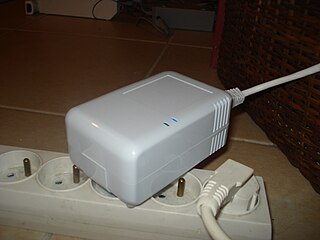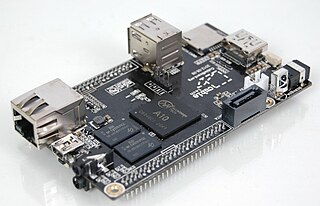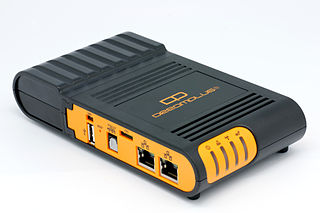
A Linux distribution is an operating system made from a software collection that includes the Linux kernel, and often a package management system. Linux users usually obtain their operating system by downloading one of the Linux distributions, which are available for a wide variety of systems ranging from embedded devices and personal computers to powerful supercomputers.

Slackware is a Linux distribution created by Patrick Volkerding in 1993. Originally based on Softlanding Linux System, Slackware has been the basis for many other Linux distributions, most notably the first versions of SUSE Linux distributions, and is the oldest distribution that is still maintained.
ARM is a family of reduced instruction set computer (RISC) instruction set architectures for computer processors, configured for various environments. Arm Ltd. develops the architectures and licenses them to other companies, who design their own products that implement one or more of those architectures, including system on a chip (SoC) and system on module (SOM) designs, that incorporate different components such as memory, interfaces, and radios. It also designs cores that implement these instruction set architectures and licenses these designs to many companies that incorporate those core designs into their own products.
XScale is a microarchitecture for central processing units initially designed by Intel implementing the ARM architecture instruction set. XScale comprises several distinct families: IXP, IXC, IOP, PXA and CE, with some later models designed as system-on-a-chip (SoC). Intel sold the PXA family to Marvell Technology Group in June 2006. Marvell then extended the brand to include processors with other microarchitectures, like ARM's Cortex.
Almquist shell is a lightweight Unix shell originally written by Kenneth Almquist in the late 1980s. Initially a clone of the System V.4 variant of the Bourne shell, it replaced the original Bourne shell in the BSD versions of Unix released in the early 1990s.

Network-attached storage (NAS) is a file-level computer data storage server connected to a computer network providing data access to a heterogeneous group of clients. The term "NAS" can refer to both the technology and systems involved, or a specialized device built for such functionality.
Technical variations of Linux distributions include support for different hardware devices and systems or software package configurations. Organizational differences may be motivated by historical reasons. Other criteria include security, including how quickly security upgrades are available; ease of package management; and number of packages available.
The NSLU2 is a network-attached storage (NAS) device made by Linksys introduced in 2004 and discontinued in 2008. It makes USB flash memory and hard disks accessible over a network using the SMB protocol. It was superseded mainly by the NAS200 and in another sense by the WRT600N and WRT300N/350N which both combine a Wi-Fi router with a storage link.
TrueNAS is the branding for a range of free and open-source network-attached storage (NAS) operating systems produced by iXsystems, and based on FreeBSD and Linux, using the OpenZFS file system. It is licensed under the terms of the BSD License and runs on commodity x86-64 hardware.

The Buffalo TeraStation network-attached storage series are network-attached storage devices.

FreeBSD is a free and open-source Unix-like operating system descended from the Berkeley Software Distribution (BSD), which was based on Research Unix. The first version of FreeBSD was released in 1993. In 2005, FreeBSD was the most popular open-source BSD operating system, accounting for more than three-quarters of all installed and permissively licensed BSD systems.
A home server is a computing server located in a private computing residence providing services to other devices inside or outside the household through a home network or the Internet. Such services may include file and printer serving, media center serving, home automation control, web serving, web caching, file sharing and synchronization, video surveillance and digital video recorder, calendar and contact sharing and synchronization, account authentication, and backup services. In the recent times, it has become very common to run literally hundreds of applications as containers, isolated from the host operating system.
iXsystems, Inc. is a privately owned American computer technology company based in San Jose, California that develops, sells and supports computing and storage products and services. Its principal products are customized open source FreeBSD distributions, including the discontinued desktop operating system TrueOS, the FreeBSD based file servers and network attached storage systems TrueNAS Core and TrueNAS Enterprise, and the Linux based TrueNAS SCALE. It also markets hardware platforms for these products, and develops enterprise-scale storage architectures and converged infrastructures. As part of its activities, the company has strong ties to the FreeBSD community, has repeatedly donated hardware and support to fledgling projects within the BSD community, and sponsors and develops development within FreeBSD, as well as being a sponsor and attendee of open-source community events.

A plug computer is an external device, often configured for use in the home or office as a compact computer. The name is derived from the small configuration of such devices; they are often enclosed in an AC power plug or AC adapter.

Tonido is remote access and home server software for network-attached storage. Once installed on a computer, Tonido software makes that computer's files available remotely via the internet through the web browser or through native mobile apps. This allows access to files stored on the computer, including music and videos, to any computing device connected to the Internet in possession of login credentials. Data is by default transmitted via Tonido's servers, with no port forwarding required, but can be transmitted without using Tonido's servers by setting up port forwarding. Data transfer speed cannot exceed that of the slowest link in the data path, including USB 2.0 for USB-connected storage.

OpenMediaVault (OMV) is a free Linux distribution designed for network-attached storage (NAS). The project's lead developer is Volker Theile, who instituted it in 2009. OMV is based on the Debian operating system, and is licensed through the GNU General Public License v3.

The Allwinner A1X is a family of single-core SoC devices designed by Allwinner Technology from Zhuhai, China. Currently the family consists of the A10, A13, A10s and A12. The SoCs incorporate the ARM Cortex-A8 as their main processor and the Mali 400 as the GPU.
Arch Linux ARM is a port of Arch Linux for ARM processors. Its design philosophy is "simplicity and full control to the end user," and like its parent operating system Arch Linux, aims to be very Unix-like. This goal of minimalism and complete user control, however, can make it difficult for Linux beginners as it requires more knowledge of and responsibility for the operating system.

DreamPlug is a compact and low power plug computer running Debian Linux, based on Marvell's Kirkwood 88F6281 ARM9E SoC. It is intended to be a device that could act as a web server, a printing server or any other network service. It uses micro-SD internal storage and an external Secure Digital slot, but also offers USB ports and a Serial ATA port to connect external disks.











